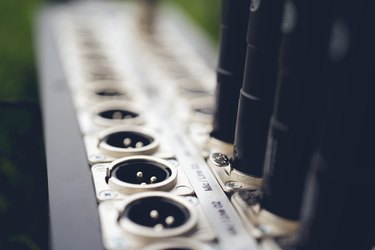
XLR cables are used in audio applications ranging from live shows to professional recording sessions. XLR cables have three pins and a circular connector. They are used to deliver balanced microphone and line-level signals over long distances, so an XLR cable can be simply thought of as a microphone cable. An XLR cable's ability to deliver a balanced signal means that the final audio signal will have less unwanted noise from outside electrical interference. This preserves the original audio signal, even over long distances and near other electronic devices.
Unbalanced Cables
Video of the Day
Unbalanced audio cables have two wires that serve as conductors; one carries both the signal and the ground. They are less expensive, but are susceptible to noise caused by interference from the electrical fields of nearby electronic devices. For this reason, unbalanced cables should not be used for audio applications that require long cables. The maximum suggested length for balanced cables is 25 to 30 feet.
Video of the Day
Balanced Cables
Balanced audio cables have three wires that serve as conductors – negative, positive and ground. The positive and negative wires both carry the audio signal but with opposite polarities. This means that any noise from outside interference sources will be cancelled out. Balanced cables are suitable for audio applications that require long lengths (more than 25 to 30 feet).
XLR Cables
XLR cables are balanced cables. They have circular connectors with three pins – positive, negative and ground. Essentially, they are the same as a Tip Ring Sleeve (TRS) cable. The only difference is the type of connector – TRS cables look like standard-jack cables. "Pin 1" (the pin on the left side when facing the male-connector, or the hole on the right side when facing the female connector) is always the ground signal on an XLR pinout.
How An XLR Cable Works
When two balanced devices are connected, the XLR cable delivers a positive audio signal, a negative audio signal and a ground signal. The positive audio signal and the negative audio signal are identical, except that they are inverted. If electrical interference is encountered, that noise enters both the positive audio signal and the negative audio signal. When the positive and negative signals reach the balanced device at the end of the chain, one of the two audio signals is inverted. Now the two audio signals are identical in every way. However, the noise that was on the audio signal has now been inverted. When the inverted noise is combined with the original noise, they cancel each other out. All that is left is the original audio signal.
Uses of XLR Cables
The most important quality of an XLR cable is that it is balanced. This makes it suitable for both live sound applications and recording studio applications. For example, if a PA (personal address) mixing board is more than 25 feet away from the band that it is amplifying, XLR cables are used. Also, XLR cables are used for connecting most microphones. Because microphones often require a power source, some mixing boards are designed to provide power. This is called "phantom power." XLR cables allow mixing boards to deliver phantom power to microphones. Most other cables cannot do this.
Other Considerations
XLR cables can only deliver a balanced signal if both devices on either end of the signal are also balanced. If any audio device in the chain is unbalanced, it will cause the whole signal chain to be unbalanced. Also, always check with the manufacturer to ensure that a device is balanced.